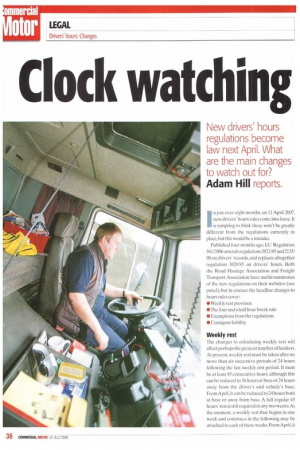C ock watching
Page 36

Page 37

If you've noticed an error in this article please click here to report it so we can fix it.
New drivers' hours regulations become
law next April. What
are the main changes to watch out for?
Adam Hill reports.
In just over eight months, on 11 April 2007, new drivers' hours rules come into force. It is tempting to think these won't be greatly different from the regulations currently in place, but this would be a mistake, Published four months ago, EU Regulation 561/2006 amends regulations 3821/85 and 2135/ 98 on drivers' records, and replaces altogether regulation 3820/85 on drivers' hours, Both the Road Haulage Association and Freight Transport Association have useful summaries of the new regulations on their websites (see panel), but in essence the headline changes to hours rules cover: • Weekly rest provision • The four and a half hour break rule • Exemptions from the regulations • Consignor liability
Weekly rest
The changes to calculating weekly rest will affect perhaps the greatest number of hauliers. At present, weekly rest must be taken after no more than six successive periods of 24 hours following the last weekly rest period. It must be at least 45 consecutive hours, although this can be reduced to 36 hours at base or 24 hours away from the driver's and vehicle's base. From April, it can be reduced to 24 hours both at base or away from base. A full regular 45 hours' rest is still required in any two weeks.At the moment, a weekly rest that begins in one week and continues in the following may be attached to each of these weeks. From April, it
may be counted in either, but not in both.
As is the case now, any reductions must be made up (or 'compensated% as the jargon has it) before the end of the third week following the week of reduction and attached to another rest period of al least nine hours in length. From April, if a driver chooses, reduced weekly rest periods may he taken in a stationary vehicle as long as sleeping facilities are up to scratch. This means drivers can choose whether or not to take a reduced weekly rest in a vehicle, although employers may still decide when those reductions are to he taken.
The daily driving limit remains nine hours per day with a possible extension to 10 hours twice a week.The total of 45 minutes' rest after four and a half hours of driving remains. However, whereas now the 45-minute break can be split into three 15-minute ones distributed over the driving period, from next April it will have to be done in two: one of 15 minutes and one of 30 minutes.
Currently, split daily rest (12 hours out of a 24-hour period) can be taken in two or three periods, each at least an hour long with the last part at least eight hours. From April, it will have to be taken in two blocks, one of at least three hours and one of at least nine hours. It is worth noting there are also alterations for daily rest concessions on double-manning operations or journeys involving ferries or trains.
So much for the weekly rest calculations and breaks. The new exemptions to drivers' hours rules need to be gone through with a fine-tooth comb, too. As James Back house, a director at transport law specialist Backhouse Jones Solicitors, says: "Don't assume that an exemption you are now reliant on will continue to exist. My advice is to look through the rules and start planning now in case you need extra resources."
Some changes could make major differences to operations. There are several instances of loopholes being removed: for example, instead of a blanket exemption for all specialised breakdown vehicles, it will soon only apply to those operating within a 100km radius of their base.
Liabilities for others
For hauliers who feel the weight of regulation falls squarely — and unfairly — on them alone, one aspect of the new rules should be of interest. There will be new, as yet unspecified, liabilities for consignors, freight forwarders and driver employment agencies in relation to drivers' hours offences. Although there is not yet any legislation on the issue, the new regulations commit the EL; to coming up with some.
Scant compensation, perhaps — but at least big, unsympathetic customers will soon find themselves legally in the frame should they start throwing their considerable weight around. Drivers' hours will be everyone's business from next April. •
























































































































































































